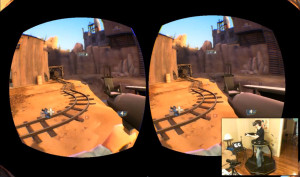The Kickstarter phenom, the Ouya, got its release earlier this year, and the results have not been kind. Pretty much anything that could go wrong for the Android console has, leaving people to wonder when the device will completely disappear from store shelves. Oculus VR, Inc is hoping to have much better results than the Ouya when they release the consumer version of the Oculus Rift late next year. The Oculus Rift is a virtual reality head-mounted display that was invented back in 2012. Although similar devices already exist, the Oculus Rift is gaining the support of important figures in the industry like Gabe Newell, Masahiro Sakurai, and others.
The Oculus Rift, like the Ouya, went through Kickstarter to secure early funding. This early funding was used to finance a developer kit of the Oculus that was sent out to developers so that they could begin to integrate the device into their games. Oculus VR used the reception that they got from the developer kit to generate more funding, this time from actual investors. As it stands, the Oculus Rift has raised $92 million with only 2.6% of that amount coming from Kickstarter. For comparison, Ouya received a total of $23.6 million with more than a third of that coming from crowdfunding. Of course these numbers have no bearing on final sales, but it is interesting that Ouya had, comparatively, so little support from outside investors and is failing because it lacks consumer interest, something that investors were likely weary about.
The move to ship a developer kit first appears to have been a great move by Oculus VR. Getting the device into the hands of developers early allowed them to not only ready Oculus support well in advance, but it also allowed the developers to give feedback on the initial build of the device. Since the device is not scheduled for release until later in 2014, Oculus VR has plenty of time to iron out issues in their device without being blasted by the public. The consumer version is expected to display in 1080p resolution (up from the 1280×800 resolution that the developer version offers) as well as improved head and position tracking, all things that will help immerse the gamer in the virtual worlds of their games.

Looking at this screenshot makes me wonder why Nintendo did not just include a bottle of aspirin with each Virtual Boy.
Long-time gamers will remember Nintendo’s Virtual Boy console when they hear about the Oculus Rift. The Virtual Boy is one of the rare failures in Nintendo’s catalog, selling only 770,000 units and lasting on the market for only six months. The reasons behind the Virtual Boy’s failure are many, one being that it was marketed towards adults during a time when video games were seen as toys for children and teenagers. Nintendo also opted to use cheaper parts for the Virtual Boy, opting to use only red LEDs because a color display was too costly. The sea of red, 3D graphics, along with the awkward position that the console had to be used in, led to many people getting headaches while playing. Granted, the Oculus Rift will have far superior technology than the Virtual Boy, but if it has the same problem with headaches, it will likely experience a similar fate as its Nintendo ancestor.
I remain on the fence with my opinion for the Oculus Rift. I think the device has some great potential, and the company behind it has made some smart decisions but the track record for head-mounted displays is not great. The inclusion of stereoscopic 3D is worrying because I have not had one 3D experience that did not leave me with a headache after only an hour of use. If the Oculus Rift can be used without requiring aspirin, it could have a fantastic effect in games like Skyrim and other first-person oriented titles. That being said, even if everything is perfect with the device, I do not see myself using it every time while playing games. The expected price of three hundred dollars is also a bit of a deterrent to me since that is money I would rather spend on an actual console rather than an accessory.
The Oculus Rift has no set release date at this time, but I expect the hype for the device to reach extreme levels as the device is finalized and nears its public release. The fact that the Rift will work with consoles will likely be a major selling point for the FPS and Madden crowd as it will only reinforce their belief that they could actually be football players or soldiers and not just brogamers. Perhaps the best move that Oculus VR can do is partner with the developer of one of the mammoth FPS series with the intent to offer a package of the Rift and the next entry in the series, such a move would surely generate sales by the bunches. Apart from brogamers, the Rift does have some potential for fans of other genres, but I think the price will still be a big wall to climb. Although it may not end up being a device that I buy, I look forward to seeing how the final product turns out and the reception it receives.
